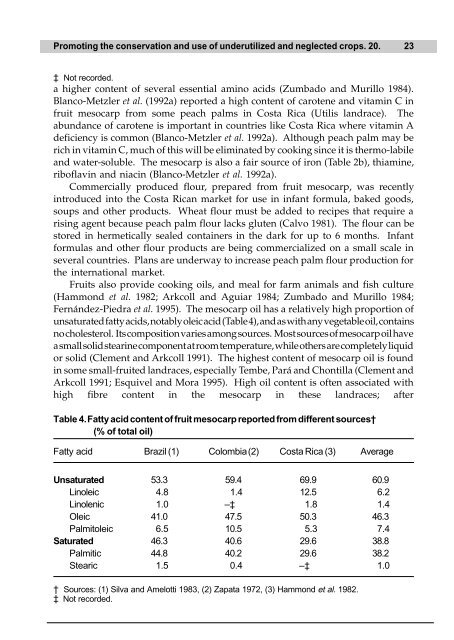Peach palm - World Agroforestry Centre
Peach palm - World Agroforestry Centre
Peach palm - World Agroforestry Centre
Create successful ePaper yourself
Turn your PDF publications into a flip-book with our unique Google optimized e-Paper software.
Promoting the conservation and use of underutilized and neglected crops. 20. 23<br />
‡ Not recorded.<br />
a higher content of several essential amino acids (Zumbado and Murillo 1984).<br />
Blanco-Metzler et al. (1992a) reported a high content of carotene and vitamin C in<br />
fruit mesocarp from some peach <strong>palm</strong>s in Costa Rica (Utilis landrace). The<br />
abundance of carotene is important in countries like Costa Rica where vitamin A<br />
deficiency is common (Blanco-Metzler et al. 1992a). Although peach <strong>palm</strong> may be<br />
rich in vitamin C, much of this will be eliminated by cooking since it is thermo-labile<br />
and water-soluble. The mesocarp is also a fair source of iron (Table 2b), thiamine,<br />
riboflavin and niacin (Blanco-Metzler et al. 1992a).<br />
Commercially produced flour, prepared from fruit mesocarp, was recently<br />
introduced into the Costa Rican market for use in infant formula, baked goods,<br />
soups and other products. Wheat flour must be added to recipes that require a<br />
rising agent because peach <strong>palm</strong> flour lacks gluten (Calvo 1981). The flour can be<br />
stored in hermetically sealed containers in the dark for up to 6 months. Infant<br />
formulas and other flour products are being commercialized on a small scale in<br />
several countries. Plans are underway to increase peach <strong>palm</strong> flour production for<br />
the international market.<br />
Fruits also provide cooking oils, and meal for farm animals and fish culture<br />
(Hammond et al. 1982; Arkcoll and Aguiar 1984; Zumbado and Murillo 1984;<br />
Fernández-Piedra et al. 1995). The mesocarp oil has a relatively high proportion of<br />
unsaturated fatty acids, notably oleic acid (Table 4), and as with any vegetable oil, contains<br />
no cholesterol. Its composition varies among sources. Most sources of mesocarp oil have<br />
a small solid stearine component at room temperature, while others are completely liquid<br />
or solid (Clement and Arkcoll 1991). The highest content of mesocarp oil is found<br />
in some small-fruited landraces, especially Tembe, Pará and Chontilla (Clement and<br />
Arkcoll 1991; Esquivel and Mora 1995). High oil content is often associated with<br />
high fibre content in the mesocarp in these landraces; after<br />
Table 4.Fatty acid content of fruit mesocarp reported from different sources†<br />
(% of total oil)<br />
Fatty acid Brazil (1) Colombia (2) Costa Rica (3) Average<br />
Unsaturated 53.3 59.4 69.9 60.9<br />
Linoleic 4.8 1.4 12.5 6.2<br />
Linolenic 1.0 –‡ 1.8 1.4<br />
Oleic 41.0 47.5 50.3 46.3<br />
Palmitoleic 6.5 10.5 5.3 7.4<br />
Saturated 46.3 40.6 29.6 38.8<br />
Palmitic 44.8 40.2 29.6 38.2<br />
Stearic 1.5 0.4 –‡ 1.0<br />
† Sources: (1) Silva and Amelotti 1983, (2) Zapata 1972, (3) Hammond et al. 1982.<br />
‡ Not recorded.

















